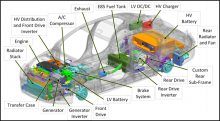If you would like to see more information on this case study, click here!
You can request this case study and a WCDE staff member will get back to you.
 The University of Waterloo Alternative Fuels Team (UWAFT) is a student team that has been participating in Advanced Vehicle Technical Competitions (AVTC) since 1996. As a part of the current competition (EcoCAR 2), UWAFT is required to modify a 2013 Chevrolet Malibu to improve fuel economy, and reduce greenhouse gas emissions, without compromising safety and consumer acceptability of the stock vehicle. During the first year of the competition, UWAFT selected the power train architecture and completed preliminary designs to integrate the architecture into the stock vehicle. The architecture UWAFT selected is an all-wheel drive series plug in hybrid electric vehicle that uses ethanol for range extension.
The University of Waterloo Alternative Fuels Team (UWAFT) is a student team that has been participating in Advanced Vehicle Technical Competitions (AVTC) since 1996. As a part of the current competition (EcoCAR 2), UWAFT is required to modify a 2013 Chevrolet Malibu to improve fuel economy, and reduce greenhouse gas emissions, without compromising safety and consumer acceptability of the stock vehicle. During the first year of the competition, UWAFT selected the power train architecture and completed preliminary designs to integrate the architecture into the stock vehicle. The architecture UWAFT selected is an all-wheel drive series plug in hybrid electric vehicle that uses ethanol for range extension.
This architecture requires a large battery pack with a plug-in charger; an ethanol compatible engine coupled to a generator, along with a fuel tank and exhaust system to recharge the battery; and two electric motors coupled to transmissions to drive all 4 wheels. Due to volumetric constraints it was decided to mount most of these additional components such as the dc/dc converter in the trunk, near the wheel wells. However, the trunk hinges of the stock vehicle are rather large and restrict the space available to mount these components along the rear wheel wells. As a result, the team needed to redesign the trunk hinge system to maximize the space available to mount these additional components. Faris Zahid a 4th year Mechanical engineering student, took on the task of redesigning the hinge as his 4th year design project, supervised by Professor Roydon Fraser.
The teaching objective of this case is to illustrate design synthesis with a realistic set of constraints and a challenging technical goal. Emphasis is placed on the effective use of engineering analysis, including kinematic analysis, to verify the design. At the end of the case, students should be able to apply the design process to redesign a kinematic linkage, and to verify this design using Adams. The case is proposed to be used in Kinematics and Dynamics of Machines (ME 321).
If you would like to see more information on this case study, click here!
You can request this case study and a WCDE staff member will get back to you.
Contact Waterloo Cases in Design Engineering
Steve Lambert
Tel: (519) 888-4728
Email: steve@uwaterloo.ca
The University of Waterloo acknowledges that much of our work takes place on the traditional territory of the Neutral, Anishinaabeg, and Haudenosaunee peoples. Our main campus is situated on the Haldimand Tract, the land granted to the Six Nations that includes six miles on each side of the Grand River. Our active work toward reconciliation takes place across our campuses through research, learning, teaching, and community building, and is co-ordinated within the Office of Indigenous Relations.